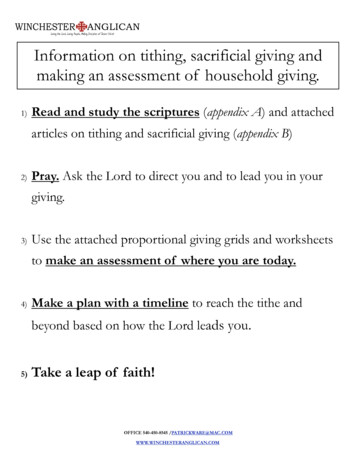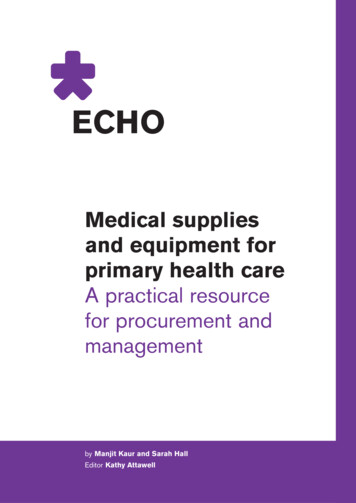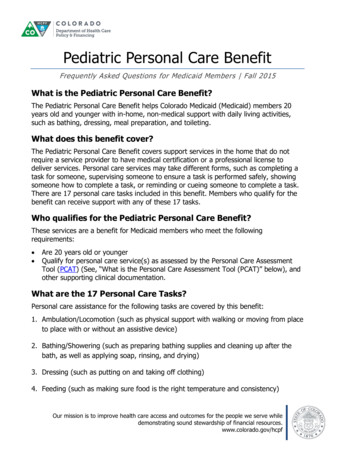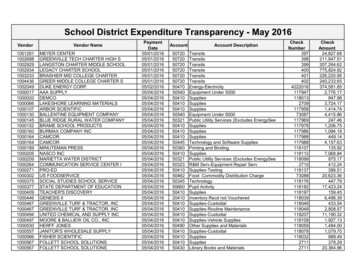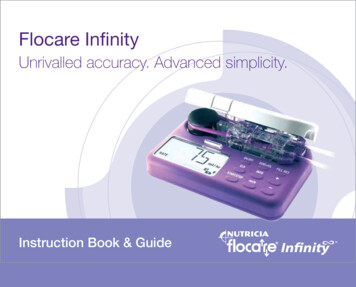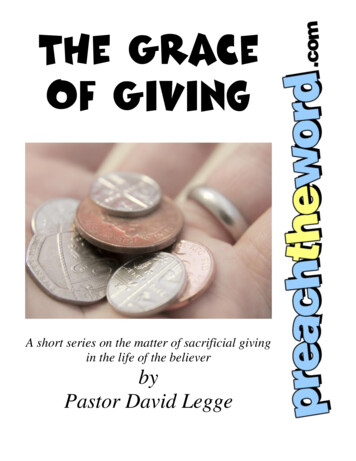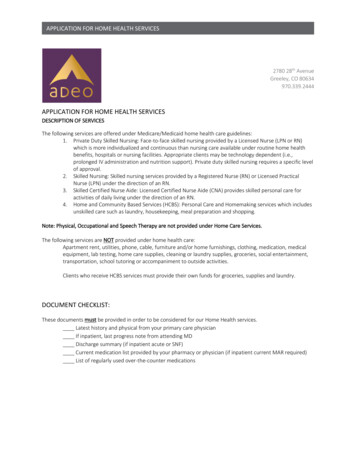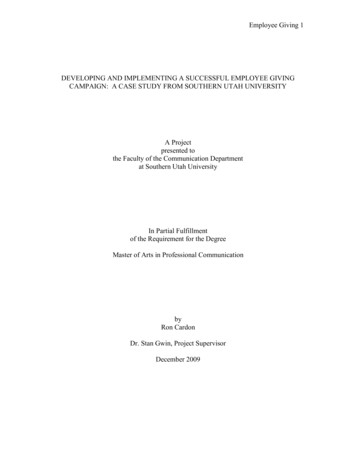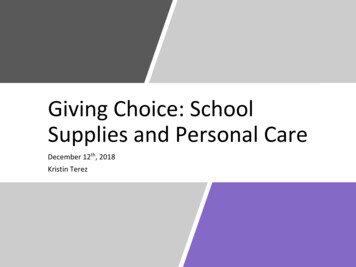
Transcription
Giving Choice: SchoolSupplies and Personal CareDecember 12th, 2018Kristin Terez
ProjectOverviewGiving Choice: School Supplies andPersonal Care is a two part social actionproject focused on providing schoolsupplies to children in need and providinghealthy personal care products tolow-income women. The overarchingproject goal is to provide options ofchoice to those who are typically unabledue to financial restriction.
Five LoavesFood Pantry The only food pantry in New Brunswick that offers “client choice” Clients are allowed to choose what they want from each category of items Protein, fruits/vegetables, pasta, canned goods, cereal, dairy, etc. Amount of food a client can take home is dependent on the amount of people living in thehousehold Five Loaves is the only pantry in the New Brunswick area that does not providepre-packaged bags of groceries Receiving a prepackaged bag of foods you might not necessarily like or may not even befamiliar with can be disappointing and degrading It’s a much more dignified experience when you’re allowed to choose what you want from avariety of food items
School Supplies Background New Brunswick U.S. Census Bureau Facts: Population of New Brunswick is 57,000 people 36% of people are living at or below thepoverty line 20,520 people in New Brunswick are living ator below the poverty line School Supplies Facts In 2017, Huntington Bank’s Backpack Indexreported that the average cost of schoolsupplies for a child in elementary school was 650. After being adjusted for inflation, the cost ofschool supplies in 2006 was 375. The cost of school supplies is on the rise andthat can be stressful for parents withlow-income.
Part One:Accessibilityof SchoolSupplies Kristin helping two elementary school girls decide which colornotebooks they would like. Photo taken on August 8th, 2018.Collected gently used school supplies from friends and familyReceived 1,175 in donations via gofundmeSurveyed pantry clients to determine which supplies were neededPurchased new school supplies with donation fundsSet up a shelving unit to display school suppliesPantry clients given opportunity to shop the shelves for school supplies
PartTwo:PersonalCareProductsObjectives: Provide lower-income women withthe option of using safer personalcare products. Educate community members onquestionable ingredients in personalcare products, while shedding light onthe lack of government regulation.Image from Morretec
My Personal Care Products:All images attained from Ulta Beauty
Ingredients: propylene glycol,polyethylene, fragrance,methylparaben, propylparaben,butane, and octinoxate
Personal Care Products Facts Toxic Ingredients Research has suggested cosmetologists, especiallynail salon workers, experience higher rates ofinfertility and miscarriages, in addition to dermatitisand breathing problems, such as asthma. New York Times “Fragrance” could be 3,000 ingredients, some ofwhich are endocrine-disrupting compounds andpossible or known carcinogens. Campaign for Safe Cosmetics Lack of Regulation in U.S. Cosmetic manufacturers are NOT legally required toreport health problems associated with use of theirproducts to the FDA. Time Canada and EU have banned or restricted 1,300cosmetic ingredients; U.S. has only banned 11. NewYork Times
“We don’t actually need any morestudies or scientific data to feelconfident about these chemicals’effects. We have reached the pointwhere doing more studies becomesa superb excuse for inaction or delayon the part of industry, when theyshould be dealing with the problemsthat have already been identified.”– Dr. Samuel S. Epstein, author of Toxic Beauty
Part 2: Personal Care ProductsWhat I’ve Done So Far:What I Plan to Do: Collected 700 in donations viagofundme Purchased safer personal careproducts for people who visit FiveLoaves Food Pantry Presented at an RU Compost clubmeeting Educated members onpersonal care productingredients Taught club members how tomake their own body lotion Host an event at the Center forGreat Expectations (a women’sshelter in Somerset, NJ) Discuss personal careproduct ingredients andpossible health effects Teach the women how tomake their own personal careproducts
Time management is noteasyLessonsLearnedStepping out of your comfortzone is worth it in the longrunYou’re not alone when you’refeeling overwhelmedPeople will support you if youjust ask
Feminist Leadership This project allowed me to Go at my own pace Acknowledge and recognize my privilege, while thinkingcritically Interact with people of different backgrounds from my own,who I wouldn’t normally interact with Empathize with people who have much differentexperiences
References Kim, D., Kang, M., Choi, S., Park, J., Lee, H., & Kim, E. (n.d.). Reproductive disorders among cosmetologists andhairdressers: a meta-analysis. International Archives of Occupational and Environmental Health, 89(5), z Craig, Z., & Ziv-Gal, A. (n.d.). Pretty good or pretty bad? - The ovary and chemicals in personal care products.Toxicological Sciences : an Official Journal of the Society of Toxicology, 162(2), 349–360.https://doi.org/10.1093/toxsci/kfx285 Guo, Y., & Kannan, K. (n.d.). A survey of phthalates and parabens in personal care products from the United Statesand its implications for human exposure. Environmental Science & Technology, 47(24), 14442–14449.https://doi.org/10.1021/es4042034 Ruszkiewicz, J., Pinkas, A., Ferrer, B., Peres, T., Tsatsakis, A., & Aschner, M. (2017). Neurotoxic effect of activeingredients in sunscreen products, a contemporary review. Toxicology Reports, 4, .006 Epstein, Samuel S. “The Chemical Threat to Your Health.” Toxic Beauty. BenBella Books, Inc., 2009, pp. 23-39. Maslin Nir, Sarah. "Perfect Nails, Poisoned Workers." The New York Times 8 May 2015. Web. 14 Nov. 2018. Zota, Ami R., and Shamasunder, Bhavna. “The Environmental Injustice of Beauty: Framing Chemical Exposures fromBeauty Products as a Health Disparities Concern.” American Journal of Obstetrics and Gynecology, vol. 217, no. 4,Elsevier Inc., Oct. 2017, pp. 418.e1–418.e6, doi:10.1016/j.ajog.2017.07.020. Helm, Jessica S., et al. “Measurement of Endocrine Disrupting and Asthma-Associated Chemicals in Hair ProductsUsed by Black Women.” Environmental Research, vol. 165, Elsevier Inc., Aug. 2018, pp. 448–58,doi:10.1016/j.envres.2018.03.030. Haydon, T. (2018, July 17). New Brunswick Battles Hunger with Largest Food Pantry Network in County. Retrievedfrom tles-hunger-with-largest-food-pa-1 Mickelson, K., & Hazlett, E. (n.d.). “Why me?”: Low-Income Women’s Poverty Attributions, Mental Health, and SocialClass Perceptions. Sex Roles, 71(9), 319–332. doi:10.1007/s11199-014-0414-4 American Psychological Association, APA Working Group on Stress and Health Disparities. (2017). Stress and healthdisparities: Contexts, mechanisms, and interventions among racial/ethnic minority and low-socioeconomic statuspopulations. Retrieved from /stress-report.aspx Tirado, L. (2015). Hand to mouth: Living in bootstrap America. New York: Berkley Books.
36% of people are living at or below the poverty line 20,520 people in New Brunswick are living at or below the poverty line School Supplies Facts In 2017, Huntington Bank’s Backpack Index reported that the average cost of school . Hand to mouth: Livin
